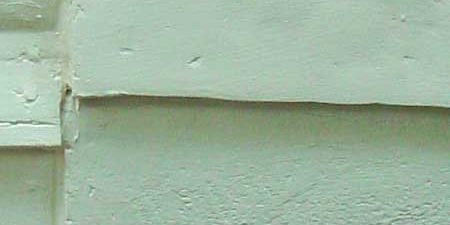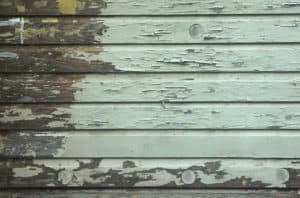Painting and Stripping Old Wood Siding — Overview
When we started to paint our house, we faced the problem of trying to decide what we could do to maximize the life of our paint job. Unfortunately, we kept finding contradictory information. Should we use a latex primer or and alkyd primer? Should we use a water repellent sealer before priming? Should we just scrape or totally remove the old paint?
Here is a summary of what we did. For full details). Go to our step-by-step page
- Strip the old paint (Go to our paint stripping page) We decided to strip the paint to give us the best chance of producing the longest lasting paint job. Be sure to remove any caulk where the siding overlaps as old houses need to breathe.
- Pull out loose nails and renail using stainless steel siding nails.
- Fill any dents and holes with either a wood or epoxy filler.
- Sand the surface.
- Apply an epoxy consolidant to soft wood and coat the rest with a wood preservative. We used the paintable Wolmans WOODLIFE® Classic Clear Wood Preservative
 if the wood was paint free.
if the wood was paint free. - Caulk cracks. We used GE Paintable Silicone Supreme Window & Door Sealant
 . Never caulk between the overlapping siding boards as this traps in moisture which will cause peeling.
. Never caulk between the overlapping siding boards as this traps in moisture which will cause peeling. - Apply one coat primer. We use Zinsser® Bulls Eye 1-2-3® PLUS Primer
 primer.
primer.
Tip: Have the paint store tint the primer to the same color as the top coat.
- Apply two coats of Home Depot's Behr Marquee Exterior
 . Behr paints have been mentioned as a top paint in various consumer studies for many years. We use Consumer Reports
. Behr paints have been mentioned as a top paint in various consumer studies for many years. We use Consumer Reports as our guide to paints.We are now using semigloss paint as it stays cleaner; however, some people do not like the glossy look.
as our guide to paints.We are now using semigloss paint as it stays cleaner; however, some people do not like the glossy look.
The experts do not agree on the use of a water sealer/preservative before priming. The National Park Service recommends it as do some other top painters. We decided to use a sealer because our area is humid and gets regular rain during the Spring and Summer. Therefore, we wanted to seal the fresh stripped wood surface as soon as possible after using the infrared heat stripper. The process of infrared heat stripping dries out the wood and allows the sealer to readily penetrate. We applied the sealer, which cleans up with water, as small areas were stripped. Since the freshly striped siding was now protected, we could wait to prime larger areas on dry days, and by priming larger areas with the alkyd primer, we were more productive in priming setup and clean up.
Hints:
- Never caulk between the overlapping siding boards. This traps in moisture. Moisture needs to flow between the inside and outside so your house can breath.
- Don't caulk unpainted wood. Caulk after using the sealer. If you don't use the sealer, caulk after priming.
- Wood that is gray or weathered will not hold paint. Sand down to fresh wood.
- Unfinished siding exposed to several weeks of sunlight before painting needs to be sanded. Sunlight degrades the unfinished wood surface, thus it will never hold paint as well as fresh wood. If the unfinished wood was exposed more than 3 to 4 weeks, lightly sand the surface to remove the thin layer of degraded wood before applying paint.
- Don't let the primer sit more than a few weeks before painting. Soap-like compounds can form on oil primers in as little as two weeks.
- Use a brush when painting old siding. It allows the paint to be worked into the siding's imperfections more effectively than a roller or spray.
- Don't prime or paint in direct sunshine, when it is dry and breezy, or is very hot (over 90 degrees F)
- Paint should not be applied when the air temperature is below when the air temperature is below the stated figure for the product, nor if the temperature is forecasted to drop below that minimum during the next 36 hours, nor if the surface being painted is below that temperature.
Oil-based paints should be applied when the temperature is at least 40 F; for latex paints, the temperature should be at least 50 F. Conditions should remain above these temperatures for 24 hours after painting. When pretreating the wood with a paintable water-repellent preservative (a recommended practice), best results are achieved if it is applied when temperatures are greater than 70 F. - Don't paint if it is too humid (between 20% and 80% is ideal). When water-based paints cure, the water should evaporate as fast or faster than the solvents. After the water has evaporated, the paint will shrink to nearly its final shape. As the solvents evaporate, the paint chemically reacts to form a hard material. When it is too humid, water cannot evaporate and the solvents may evaporate first, causing the paint to cure while still in a water-filled state. You cannot recover from this type of disaster. Oil-based paints will also fail if conditions are too humid.
Additional information:
Repairing old windows![]() (National Park Service)
(National Park Service)
Exterior paint problems on historic woodwork (National Park Service)![]()
Using a water sealer/preservative before priming
Painting pressure treated wood
Removing mildew from surfaces![]() —Wet and Forget Commercial
—Wet and Forget Commercial
Product
Primers
Wolmans WOODLIFE® Classic Clear Wood Preservative![]()
Smith and Co's MultiWoodPrime epoxy primer![]()
Epoxy fillers and consolidants
Rot Doctor's Penetrating Epoxy and FILL-IT™ Epoxy Filler![]()
Abatron's LiquidWood and WoodEpox![]()
Only buy enough epoxy for a year as it doesn't keep well.
|
Help support this site
|



